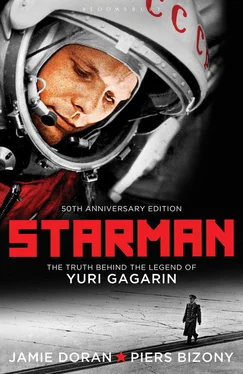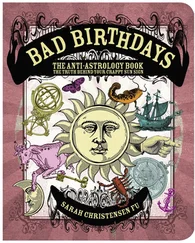True to form, Gagarin had worked on the landing problem with bloody-minded determination and had solved it, cushion and all. Now for the target practice. After all, what was the use of a military pilot who could not shoot the guns on his plane? At first, his practice gunnery strafes fell completely wide of the target, while his classmates at Orenburg scored bull’s-eyes. Gagarin re-sat all the theoretical classes on the ground, tried again from the air and eventually destroyed his targets in the approved manner.
One notable sporting incident boosted Gagarin’s career prospects while he was captaining the Junior Cadets’ basketball team. After one particular game, where they thrashed the opposition, the tutors at Orenburg praised him for his skilful play. ‘We didn’t win because we played better,’ he said. ‘We won by sheer determination. We were bent on winning, while the other side hadn’t made up their minds.’ This statement impressed some of the senior officers watching the game. Akbulatov and his colleagues began to think of Gagarin as a contender. No genius, but a winner for all that. Plus, he was a young man who loved pulling heavy g’s, an appropriate enthusiasm for a would-be fighter pilot.
At Orenburg, Gagarin met Valentina ‘Valya’ Goryacheva, a pretty, hazel-eyed medical technician one year younger than him. She worked on the Orenburg base, and came to a dance party one evening, only to find that the callow cadets with their short, bristly haircuts did not seem particularly impressive. In an interview with journalist Yaroslav Golovanov in 1978, she recalled that the civilian boys in downtown Orenburg seemed better dressed, had nicer hair and were more handsome. She never expected to find a love match at a military compound, just a pleasant night’s partying. She danced with Gagarin a couple of times, while he cheerfully asked questions about her. [9] Golovanov, Our Gagarin , pp. 263–4.
At ten o’clock precisely the music stopped. The cadets were expected to go to bed now (alone), so that they would be ready for an early start the next morning. Gagarin said, ‘Well. See you next Sunday.’ Valya made no reply. ‘Back home, I thought: Why should I go and meet that bald-headed character again? In any case, why does he behave in such an assured way? But the next Sunday we went to the cinema. We had a difference of opinion about what we saw. Then afterwards he said, “Well. See you next Sunday.”’
And he did. Valya’s parents, Ivan Goryachev and Varvara Semyonova, lived in Chicherin Street, Orenburg. Valya had never known any other home town, but for Gagarin this place was entirely new and unknown. Valya’s parents, along with her three brothers and three sisters, quickly became fond of him and their house became a kind of second home. Ivan cooked for the local sanatorium and applied his considerable chef’s talent at home. No great fan of the dull food at the flying school, Gagarin ate well during his many off-duty visits to Chicherin Street. According to Valya, when she was interviewed in 1978, there was only one serious problem on Gagarin’s mind at that time: ‘His parents were having a hard time making ends meet, but how could Yura help them in any way from his small cadet’s pay? He said it would have been better if he had gone back to Gzhatsk as soon as he’d finished at the Technical School so that he could earn a living in the profession he had learned, as a foundryman.’ But Gagarin persisted with his training at Orenburg, achieving the rank of Sergeant in February 1956, and making his first solo flight in a MiG-15 jet on March 26, 1957.
On October 4, 1957, the Soviets launched the world’s first artificial satellite. The cadets at Orenburg rushed around in great excitement when they heard the news. Gagarin’s best friend on the base, his namesake Yuri Dergunov, ran towards him on the tarmac shouting ‘Sputnik!’ at the top of his voice. Gagarin was excited too, but the moment did not immediately change his life, as some accounts have suggested. He was much more concerned with his pending final exams at the Pilots’ School, and with his growing love for Valya. The date for their marriage was already set for October 27. He recalled that at the time the wedding arrangements seemed far more pressing to him than any thoughts of flying into space; besides, the idea of sending people into the cosmos still seemed a distant abstraction. He never imagined that he would be in orbit in three-and-a-half years’ time.
Valya had no idea that rocket travel would feature in her husband’s life. She married a charming but essentially ordinary young military flier, not some future space hero. She must have known the risks involved, even in this simple relationship: that she would end up moving from one strange town to another as Yuri moved between different air stations; that he might set out to work one morning and not come back in the evening… Obviously she made these accommodations. She was entitled to expect that the military would assist with housing, health care, pensions and schooling for any children she and Yuri might raise. In return, she knew that she might have to grieve silently and without fuss if her husband was killed flying in his jet plane. Many other wives in her position shared the same burdens, the same nagging fears, and to some extent this must have helped. Valya made several close friends among the pilots’ wives and, later, among the wives of the cosmonauts. What she never anticipated was becoming the wife of the World’s Most Famous Man. She was a shy and intensely private young woman.
Nor was Valya thrilled with her new husband’s first proper posting after he passed out of Orenburg with excellent grades and a Lieutenant’s commission on November 6, 1957. Shortly after graduating, Gagarin was sent to the Nikel airbase on the northernmost tip of Murmansk, 300 kilometres north of the Arctic Circle, with an assignment to fly MiG-15 jets on reconnaissance missions. Valya followed him out there and discovered a terrible hinterland of sub-zero temperatures, biting winds and long, pitch-black nights, interspersed by a few hours of gloomy grey daylight. Here, on April 10, 1959, she gave birth to the couple’s first daughter, Lena.
Throughout the long winter months flying conditions at Nikel were awful. Ice menaced the control surfaces of Gagarin’s MiG, and snow blindness was a constant threat, with the sky and the ground merging into a seamless sheet of white with no discernible horizon. The on-board electronic approach and landing systems of a MiG were not particularly sensitive in those days. Snow-blinded pilots had to rely on the bigger ground-control radars to guide them towards the narrow radio beacons on the perimeter of the runway. Even in clear weather there were hazards. One day Gagarin put his plane down on a landing strip covered in black ice, transparent to the naked eye but slippery as oil. He had never practised at Orenburg for these conditions. His plane skidded violently and the landing gear’s tyres burst under the strain of his sudden braking.
Gagarin’s good friend Yuri Dergunov from the Orenburg Pilots’ School had campaigned hard to be assigned the same posting when he qualified. It was a great shock when he crashed and was killed in his first month at Nikel. Valya recalled, ‘For several weeks Yuri walked around in a daze and spent one sleepless night after another. I knew that no relaxing draughts or sleeping pills would help him, and if I offered him medicine it was only to take his mind off his depressing thoughts for a few moments at least.’ [10] Ibid., p. 265.
In October 1959 mysterious recruiting teams arrived without warning at all the major air stations in the Soviet Union, including Nikel. They did not say exactly what they wanted, or which organization they represented. Groups of pilots were selected and summoned into an office, twenty or so at a time, for an informal conversation with some ‘doctors’. A few days later the requested groups became smaller, the many rejects winnowed out through mysterious consultations in the background, until eventually the recruiters were holding private interviews with just one candidate at a time, from a shortlist of perhaps a dozen from any given airbase. These lucky ones were sent to the Bordenko Military Hospital in Moscow for a series of rigorous health checks. In all, nine out of ten candidates failed this stage of the review process, again because of secret decisions taken behind closed doors.
Читать дальше












